27 Rivers to Know
Throughout history, rivers have been important for transportation, agriculture, and the economy. Some of the most ancient civilizations have been associated with specific river valleys. Battles and even wars have turned on an army's ability or inability to cross a river in strength. But I find a lot of maps can obscure their importance by putting more focus on roads and political boundaries. So in this post I've collected a list of rivers, organized by continent, that I think are worth knowing about. For each one, I've included a map of the drainage basin (from Wikipedia), some facts on its size (from Tables 7 & 8 in The World's Water, Vol. 8, by Peter H. Gleick), and a reason for its inclusion in this list.
North America
1. Saint Lawrence
The Saint Lawrence River is located in Canada, and along the Canada–US border. Its basin area is 1,055,000 km2 and includes all of the Great Lakes. It has an average flow of 30.1 billion cubic metres per month. Beluga whales can be found in this river. The Saint Lawrence Seaway is an important shipping route.

2. Hudson
The Hudson River in New York state has a basin area of 37,000 km2 and an average flow of 1.7 billion cubic metres per month. Its connection to the Great Lakes via the Erie Canal contributed to New York City's rise, as discussed in a chapter in Water: The Epic Struggle....
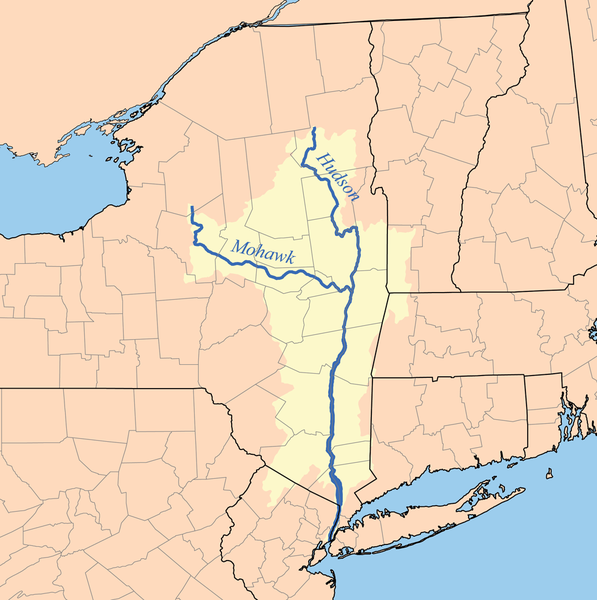
3. Chesapeake Bay
As its name indicates, the Chesapeake Bay is not a river; however, its basin area is often considered as a whole. Two of the main rivers that flow into the bay are the Susquehanna and Potomac. The capital of the United States sits on the banks of the latter. Those two rivers have a combined basin area of 101,000 km2 and a combined average flow of 3.6 billion cubic metres per month—the watershed for the whole bay includes some additional rivers and would be greater.
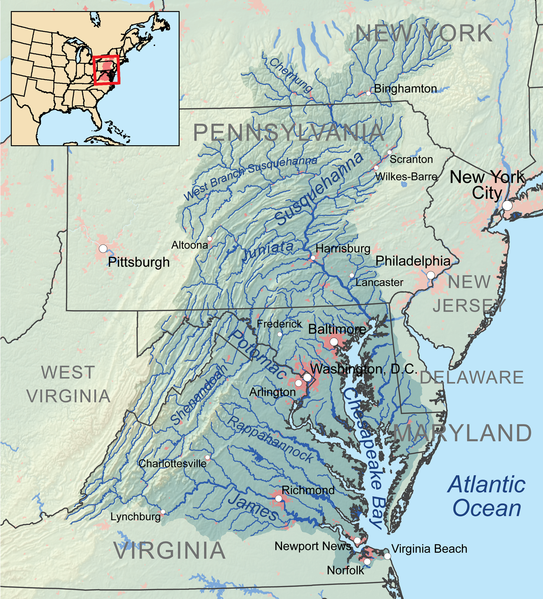
4. Mississippi
The Mississippi River's basin area covers a huge portion of the continental United States, stretching further than from Denver to Pittsburgh. It has a basin area of 3,197,000 km2 and an average flow of 54.5 billion cubic metres per month. Its major tributaries include the Ohio, Missouri, and Platte rivers.

5. Colorado
The Colorado River includes the famous Grand Canyon and Hoover Dam, and is (at times contentiously) shared between seven U.S. states and part of Mexico. It has a basin area of 640,000 km2 and an average flow of 1.7 billion cubic metres per month.
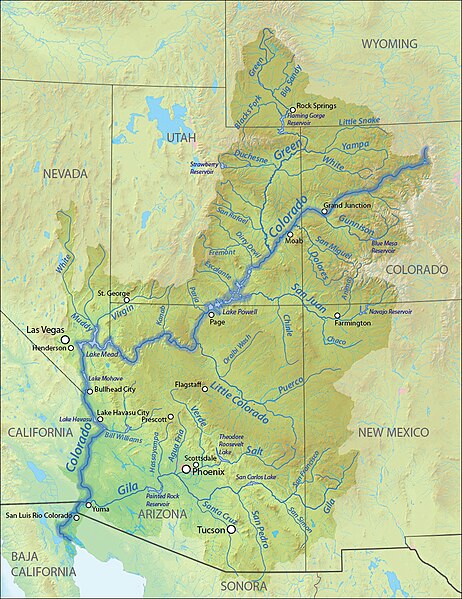
6. Columbia
According to Wikipedia,
The 14 hydroelectric dams on the Columbia's main stem and many more on its tributaries produce more hydroelectric power than those of any other North American river.
It has a basin area of 669,000 km2 and an average flow of 19.3 billion cubic metres per month.

7. MacKenzie
Great Slave Lake receives water from rivers such as the Athabasca and Peace. It is then drained by the MacKenzie River. The overall basin has an area of 1,752,000 km2 and an average flow of 23.3 billion cubic metres per month.
I recently watched a documentary about this river, titled Cold Amazon. I was interested to learn that fresh water flowing into the Arctic Ocean (from the MacKenzie as well as some Siberian rivers) has a large impact on sea ice formation and on the climate of large areas of North America.

8. Nelson
The Nelson River flows out of Lake Winnipeg, which is fed by the Saskatchewan River and others (such as the Red). The overall basin has an area of 1,099,000 km2 and an average flow of 7.6 billion cubic metres per month.

Honourable Mentions
- Fraser River – in British Columbia
- Saint John River – in New Brunswick
- Delaware River – crossed by George Washington during the Revolutionary War; has lots of ship traffic to Philadelphia
- Rio Grande – forms part of the Mexico–US border; subject of a previous blog post
South America
9. Amazon
The Amazon dwarf almost all others, with a basin area of 5,881,000 km2 and an average flow of 547 billion cubic metres per month.
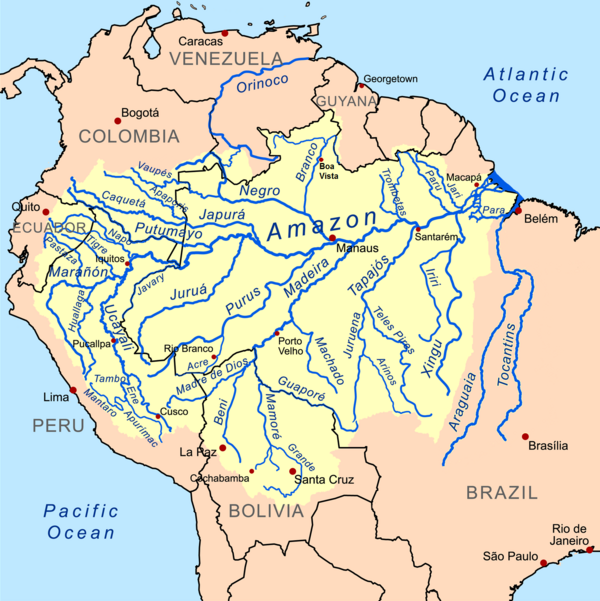
10. Rio de la Plata
The Rio de la Plata is an estuary fed by the Parana and Uruguay rivers, plus some smaller ones. Those two main rivers have a combined basin area of 2,906,000 km2 and a combined average flow of 60.0 billion cubic metres per month. This basin contains much more of South America's population than the Amazon does.
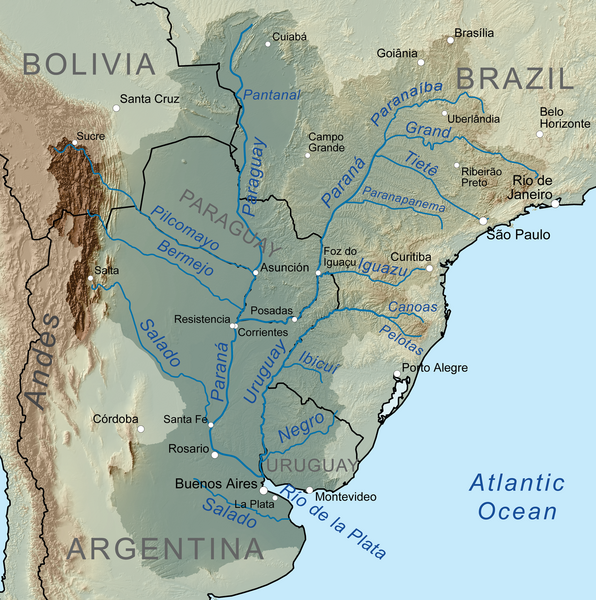
Honourable Mentions
- Catatumbo River – an atmospheric phenomenon results in very frequent lightning storms over its mouth
- Orinoco – also in Venezuela, this basin includes Angel Falls, the tallest in the world
Europe
11. Rhône
The Rhone river in France has a basin area of 97,000 km2 and an average flow of 4.5 billion cubic metres per month. The city of Lyon sits at the confluence of the Saone with the Rhone. A canal system connects the Rhone to the Rhine.
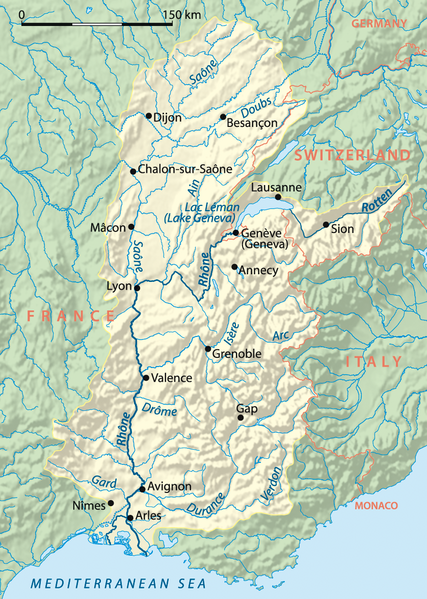
12. Seine
Paris is built along the Seine and a famous district of that city is known as the left bank. This watershed reaches almost to Dijon at its upper end, and has its mouth at Le Havre. It has a basin area of 74,000 km2 and an average flow of 1.2 billion cubic metres per month.

13. Thames
The River Thames is relatively small in size (it has a basin area of 12,000 km2 and an average flow of 0.2 billion cubic metres per month), but it is included on this list because of what sits on its banks—basically the heart of the English-speaking world: Westminster, the Globe theatre, St. Paul's, etc.

14. Rhine
The Rhine is an important transportation artery for Germany and some of the surrounding countries. It has a basin area of 191,000 km2 and an average flow of 7.1 billion cubic metres per month.

15. Danube
The Danube flows through even more European countries (10, plus 9 more when its tributaries are included) than the Rhine. These two rivers are linked by a canal, tying a significant part of the continent into a floating transportation network. Major cities along the Danube include Vienna, Budapest, and Belgrade. It has a basin area of 794,000 km2 and an average flow of 17.9 billion cubic metres per month.
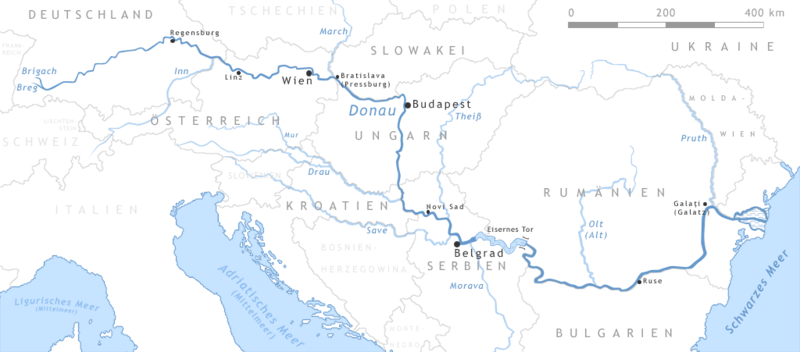
Honourable Mentions
- Elbe – its watershed includes the cities of Hamburg and Berlin
- Douro – flows through wine country in Spain down to Porto in Portugal
- Ebro – the namesake of the Iberian penninsula
- Guadalquivir – Spanish ships filled with New World silver once sailed up the Guadalquivir
- Tiber – this is to Rome what the Thames is to London
- Rubicon – a small Italian river made proverbial by Caesar's crossing
- Loire – its valley is lined with vineyards and chateaux
- Dnieper – mainly in Ukraine
Africa
16. Nile
Everyone knows the Nile. It vies with the Amazon for the title of longest river in the world and its floodplains have nourished numerous empires through the ages. It has a basin area of 3,078,000 km2 and an average flow of 29.6 billion cubic metres per month.

17. Congo
The Congo River is second in flow only to the Amazon. Some of the African Great Lakes (namely, Kivu and Tanganyika) drain to the Congo, others to the Nile, and Lake Malawi drains to the Zambezi system. The Congo River has a basin area of 3,699,000 km2 and an average flow of 105.7 billion cubic metres per month.
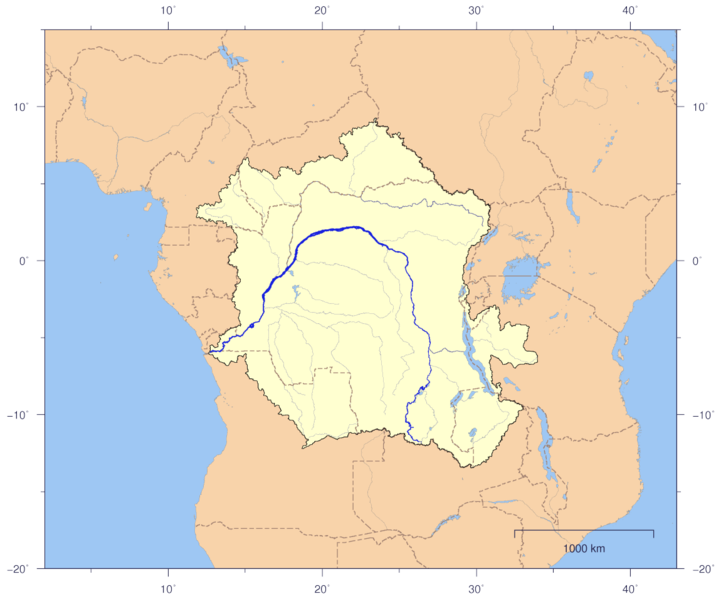
18. Niger
The Niger River has a basin area of 2,118,000 km2 and an average flow of 28.2 billion cubic metres per month. Cities such as Timbuktu and Gao along this river were important centres in the historic trans-Saharan trade between West Africa and the Mediterranean.
Honourable Mentions
- Okavango – it has no outlet to the sea
- Zambezi – this river is just behind the Niger in its monthly flow
Asia
19. Tigris & Euphrates
The Tigris and Euphrates rivers, along with the Nile and the Indus, harboured some of the earliest civilizations. Mesopotamia means "between the rivers". Together, these two rivers have a basin area of 833,000 km2 and an average flow of 11.6 billion cubic metres per month.

20. Volga
This one is miscategorised—the Volga is actually in the European part of Russia (West of Urals). It is considered the "national river of Russia" and has a basin area of 1,408,000 km2 and an average flow of 22.5 billion cubic metres per month. Caviar comes from its delta in the Caspian Sea.
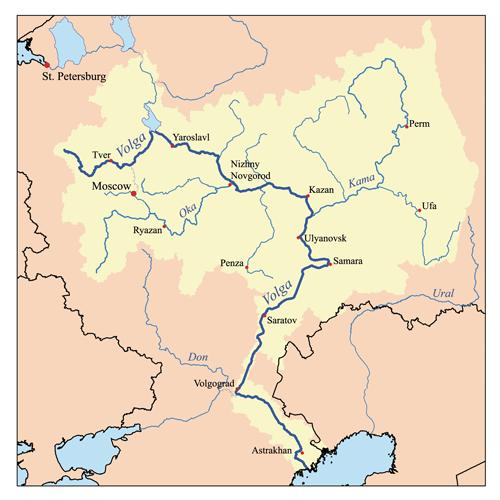
21. Indus
The Indus River has a basin area of 1,139,000 km2 and an average flow of 20.0 billion cubic metres per month. As mentioned, it supported a notable early civilization.
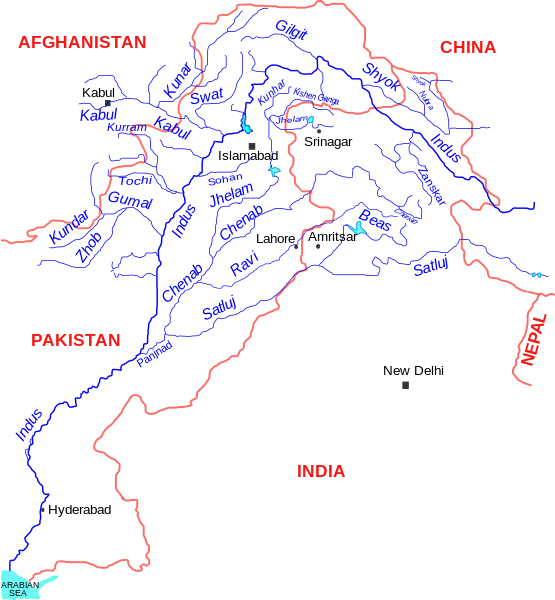
22. Ganges-Brahmaputra
The country of Bangladesh is the delta of a large river system: the Ganges–Brahmaputra. This system has a basin area of 1,542,000 km2 and an average flow of 99.0 billion cubic metres per month.

23. Irrawaddy
The Irrawaddy River has a basin area of 412,000 km2 and an average flow of 42.8 billion cubic metres per month. It primarily flows through the country of Myanmar (formerly known as Burma).

24. Mekong
The Mekong River is shared by six countries in Southeast Asia. It has a basin area of 787,000 km2 and an average flow of 41.1 billion cubic metres per month.
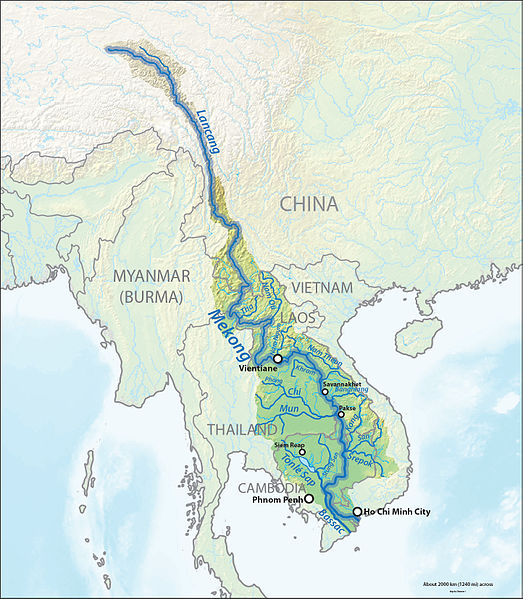
25. Yangtze
The Yangtze River has a basin area of 1,745,000 km2 and an average flow of 76.4 billion cubic metres per month. According to Wikipedia,
The river is the longest in the world to flow entirely within one country. It drains one-fifth of the land area of the People's Republic of China (PRC) and its river basin is home to one-third of the country's population.
The Three-Gorges Dam is built on this river.
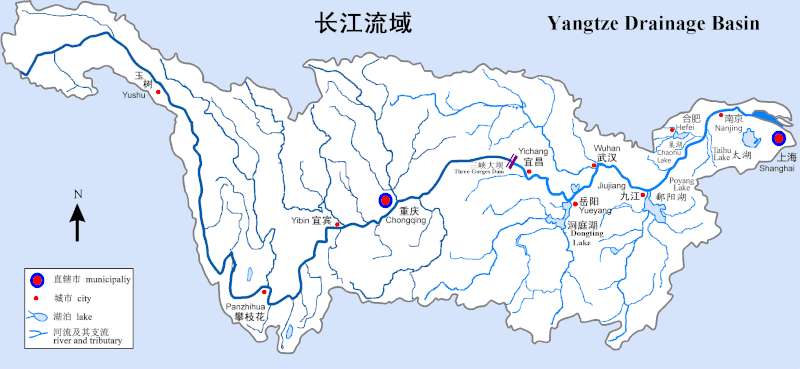
26. Yellow (Huang He)
The Yellow River also flows in China, but it is very different from the Yangtze. It
has a basin area of 988,000 km2 and an average flow of 5.7 billion cubic metres per month; the north of China where it flows is much drier than the southern Yangtze basin. The politically powerful north relies on agricultural resources from the south.
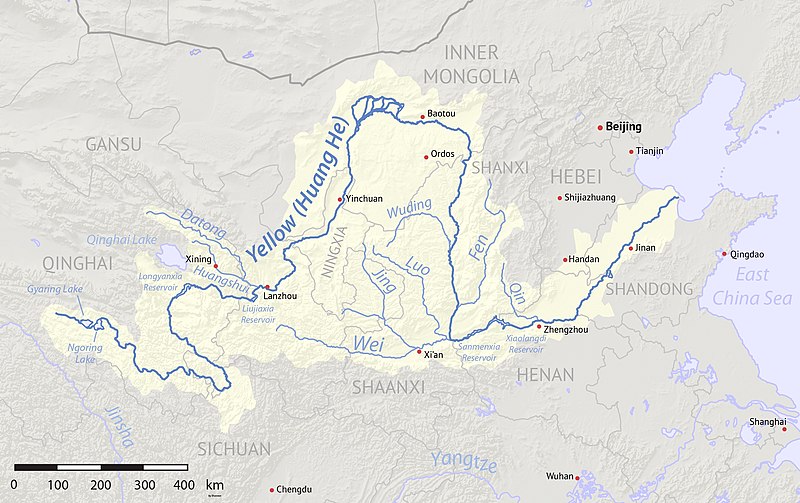
Honourable Mentions
- Ob, Yenisei, and Lena – these three great Siberian Rivers would be more than honourable mentions except that so few people live there; they are all in the top-15 global rivers by discharge and together send a total of 124.5 billion cubic metres per month to the Arctic Ocean
- Pearl – its delta region (which includes Hong Kong and Guangzhou) is one of the largest and densest urban areas in the world
- Syr Darya and Amu Darya – flow to the disappearing Aral Sea
- Jordan – included for its Biblical significance
- Yalu – forms part of the border between China and North Korea
Oceania
27. Murray-Darling
The Murray-Darling river system in Australia is an important agricultural region in a continent with scarce water resources. It has a basin area of 1,060,000 km2 and an average flow of only 2.2 billion cubic metres per month. To help manage the demand for this limited resource, a trading system was established for water rights here.
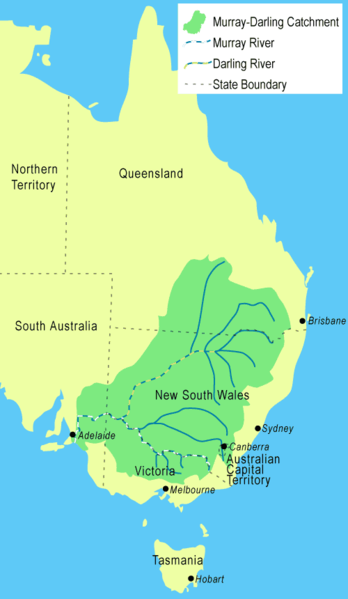
Honourable Mention(s)
- Clutha – some of the scenes of Lord of the Rings were filmed along tributaries to this river (near Queenstown, New Zealand)
